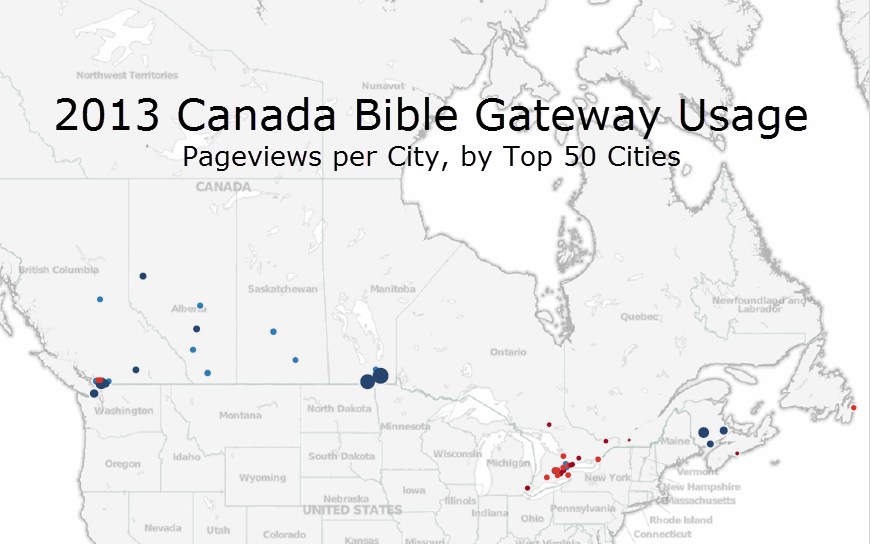Steinbach, Manitoba ranks #1 as Bible Gateway’s most “Bible-minded” city in Canada for 2013.
In our previous post, we assembled usage data from 2013 of visitors to BibleGateway.com that indicate Bible Gateway’s popularity in U.S. cities while also controlling for population. By popular demand, we’ve now done the same thing with visitor data from Canadian cities and compiled a list of the top 50 cities. Remember, our data show overall usage regardless of how the reader (visitor) feels about the Bible’s accuracy.
[UPDATE: Read our summary post What Does it Mean to be “Bible-minded”?]
The colors indicate usage: dark blue are those cities where Bible Gateway is most popular, light blue are next, then light red, then dark red. The larger the size of the dot, the more relative pageviews occurred from that location on Bible Gateway. We’ve detailed British Columbia and Ontario in the maps below for easier viewing.
Here’s the complete list:
Bible Gateway’s Most “Bible-Minded” Cities in Canada
- Steinbach, MB
- Winkler, MB
- Langley, BC
- Fredericton, NB
- Victoria, BC
- Moncton, NB
- Abbotsford, BC
- Saint John, NB
- Waterloo, ON
- Grande Prairie, AB
- Red Deer, AB
- Kelowna, BC
- Vancouver, BC
- Lethbridge, AB
- Saskatoon, SK
- Richmond, BC
- Toronto, ON
- Edmonton, AB
- Calgary, AB
- Richmond Hill, ON
- Winnipeg, MB
- Chilliwack, BC
- Prince George, BC
- Surrey, BC
- Regina, SK
- London, ON
- Kitchener, ON
- Barrie, ON
- Kingston, ON
- St. Catharines, ON
- Guelph, ON
- Burnaby, BC
- Coquitlam, BC
- Brantford, ON
- Markham, ON
- Brampton, ON
- St. John’s, NL
- Windsor, ON
- Oshawa, ON
- Oakville, ON
- Hamilton, ON
- Ajax, ON
- Peterborough, ON
- Mississauga, ON
- Ottawa, ON
- Greater Sudbury, ON
- Burlington, ON
- Halifax, NS
- Vaughan, ON
- Montreal, QC
We have several Canadian bloggers as members of the Bible Gateway Blogger Grid. You may also be interested in reading our blogpost, 2013 Year in Review on Bible Gateway.









 Last month, with the help of our friends at
Last month, with the help of our friends at 



 Today is
Today is